By Joshua Holland
NORTHWEST ASIAN WEEKLY

Port of Seattle Commissioners (L to R): Peter Steinbrueck, Stephanie Bowman, Commission President Courtney Gregoire, Fred Felleman, Ryan Calkins. (Photo from Port of Seattle)
Thanks to companies like Amazon and Microsoft, when most people think of jobs in the Seattle area, their minds frequently turn to technology. But behind the scenes, helping connect Seattle to the rest of the world and playing a vital role in moving goods around the globe, is the Port of Seattle’s role. Its lucrative cruise business alone brings in about $2.7 million every time a cruise ship docks.
Additionally, the Port of Seattle provides family wage jobs at SeaTac Airport, Fishermen’s Terminal, and its administration building.
To ensure this wealth is spread equitably, the Port has begun exploring ways to expand its impact and create new pathways for minority communities to access economic opportunities. Over the last few years, the Port of Seattle’s contracting for minority- and women-owned business has been about 5 percent.
To bring these numbers up, the Port last year spent time soliciting feedback from minority communities, asking how it could improve.
“Traditionally, we’ve measured diversity and contracting primarily by looking at women- and minority-owned business (WMBE) participation in large capital construction projects like the third runway or north satellite contracts,” said Commissioner Stephanie Bowman. “Portwide, we’re thinking about other items as well, such where we get boxed lunches or order office paper for example. While it might not sound like a lot, it adds up.”
In January, the Port of Seattle passed a new policy with the intent of tripling the number of contracts it holds with WMBEs and tying performance of Port directors to goals they’re expected to meet in terms of diversity in contracting. This includes being more intentional about hiring workers. The priority hire policy, which was recently adopted as well, now requires Port of Seattle contract holders to hire from disadvantaged zip codes in King County, and it places an emphasis on hiring minorities and women. Prior to the adoption of the policy, general contractors had few hiring guidelines. In the last few years, the Port has also provided on-the-job training and apprentice programs. Last February, it authorized $1.2 million towards the next two years of training.
The Port is also looking to the younger generation and targeting high schools. This exposure provides students with valuable on-the-job training and experiential learning opportunities.
Former intern Emile Gauvin discovered an opportunity at Fisherman’s Terminal while he was a student at Aviation High School. The opportunity allowed him to gain real world experience, which eventually led him to a full-time job with the Port, where he works today as a dock specialist.
“The Port has been great to me,” said Gauvin. “They’re invested in my education through their tuition reimbursement program and have helped me envision what I want to do with my career, more than when I was fresh out of high school.”
With the Port’s assistance, Gauvin is now a junior at the University of Washington Bothell studying business. Once he’s done with his degree, Gauvin plans to explore other opportunities within the Port and eventually obtain a management position.
Last year, the Port of Seattle had over 150 interns, many of them from South King County. The Port hopes the opportunity will help students uncover unexpected career paths.
“Kids don’t necessarily hear about these opportunities these days,” said Bowman. “The Port provides good family wage jobs. In many cases, they don’t require a four-year degree, reducing the need for young adults to take out $40,000–$50,000 of student loan debt.”
Joshua can be reached at info@nwasianweekly.com.


